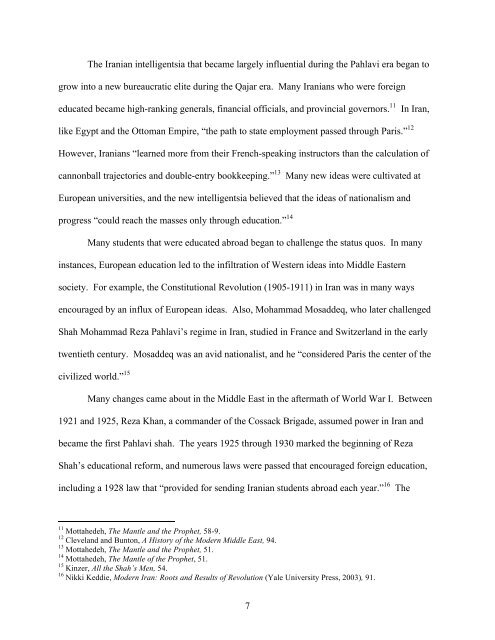AN AUGURY OF REVOLUTION: THE IRANIAN STUDENT ...
AN AUGURY OF REVOLUTION: THE IRANIAN STUDENT ...
AN AUGURY OF REVOLUTION: THE IRANIAN STUDENT ...
Create successful ePaper yourself
Turn your PDF publications into a flip-book with our unique Google optimized e-Paper software.
The Iranian intelligentsia that became largely influential during the Pahlavi era began to<br />
grow into a new bureaucratic elite during the Qajar era. Many Iranians who were foreign<br />
educated became high-ranking generals, financial officials, and provincial governors. 11<br />
In Iran,<br />
like Egypt and the Ottoman Empire, “the path to state employment passed through Paris.” 12<br />
However, Iranians “learned more from their French-speaking instructors than the calculation of<br />
cannonball trajectories and double-entry bookkeeping.” 13<br />
Many new ideas were cultivated at<br />
European universities, and the new intelligentsia believed that the ideas of nationalism and<br />
progress “could reach the masses only through education.” 14<br />
Many students that were educated abroad began to challenge the status quos. In many<br />
instances, European education led to the infiltration of Western ideas into Middle Eastern<br />
society. For example, the Constitutional Revolution (1905-1911) in Iran was in many ways<br />
encouraged by an influx of European ideas. Also, Mohammad Mosaddeq, who later challenged<br />
Shah Mohammad Reza Pahlavi’s regime in Iran, studied in France and Switzerland in the early<br />
twentieth century. Mosaddeq was an avid nationalist, and he “considered Paris the center of the<br />
civilized world.” 15<br />
Many changes came about in the Middle East in the aftermath of World War I. Between<br />
1921 and 1925, Reza Khan, a commander of the Cossack Brigade, assumed power in Iran and<br />
became the first Pahlavi shah. The years 1925 through 1930 marked the beginning of Reza<br />
Shah’s educational reform, and numerous laws were passed that encouraged foreign education,<br />
including a 1928 law that “provided for sending Iranian students abroad each year.” 16 The<br />
11 Mottahedeh, The Mantle and the Prophet, 58-9.<br />
12 Cleveland and Bunton, A History of the Modern Middle East, 94.<br />
13 Mottahedeh, The Mantle and the Prophet, 51.<br />
14 Mottahedeh, The Mantle of the Prophet, 51.<br />
15 Kinzer, All the Shah’s Men, 54.<br />
16 Nikki Keddie, Modern Iran: Roots and Results of Revolution (Yale University Press, 2003), 91.<br />
7















